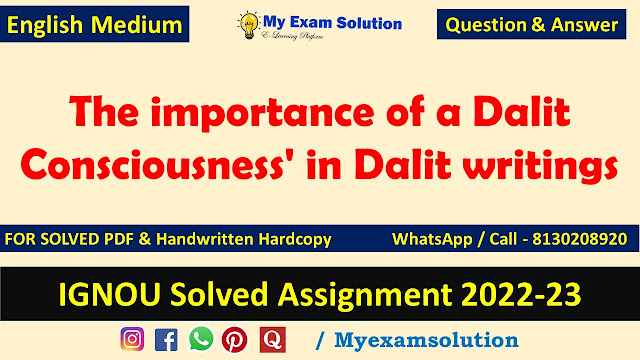The importance of a Dalit Consciousness' in Dalit writings
(In
commemoration of the Dalit History Month, we will be revisiting our archives
with articles on the question of Dalit identity, politics and history
throughout April. In this piece from September 2006, Shivam Vij the Indian
middle-class anger against reservations for Other Backward Classes. More
articles from the series are here.) Hindi Dalit literature’s moment has
arrived. After years of obscurity and unflattering comparisons to the maturity
and expressiveness of Dalit literature in languages such as Marathi and Tamil,
creative Dalit writing in Hindi is finally reaching a more visible level of
popular recognition.
Hindi Dalit
novels, autobiographies, short-story and poetry anthologies, as well as volumes
of literary criticism, are today being regularly published by Delhi’s top
Hindilanguage publishing houses, Rajkamal and Radhakrishna Prakashan. Dalit
writers infuse the pages of Delhi’s top Hindi literary magazines, such as Hans
and Katha Desh, with their poetry, prose and political perspectives. And in
January, for the first time, a Dalit writer working in Hindi, the Delhi-based
author Ajay Navaria, will participate in the international Jaipur Literature
Festival.
With the
growing shift of Hindi Dalit literary voices from marginalised spheres of
‘alternative’ social discourse to more mainstream platforms, Hindi Dalit
literature is quickly becoming deeply embedded in the changing cultural
politics of modern India.
But it is
wrong to think of Dalit literature as speaking in a single voice in the Hindi
literary and political landscapes. In what might be best categorised as the
Hindi Dalit literary sphere, there exists a plurality of people, life
experiences, literary voices and perspectives that often find themselves at
odds with one another when trying to fulfil the demands of a mainstream
audience for a recognisable, ‘authentic’ and even ‘digestible’ Dalit literary
voice. There are fissures within the Dalit literary sphere, situated along the
fault-lines of gender, geography (urban and rural) and class, which create a
vibrant and vital field of debate over the strategies of ‘writing resistance’.
The idea of a ‘Dalit consciousness’ is a central concept in both the creation
and evaluation of Dalit literature. This is the Dalit chetna, an experiential
and political perspective made up of the firsthand knowledge of caste-based
oppression and atrocity, along with the political goal of a liberating
awakening that results from the exposure of this atrocity as central to the
maintenance of caste hierarchies.
Yet the
realities of overlapping identities of class, gender and geography among the
writers of the Hindi Dalit literary sphere necessarily complicate any
simplistic or conclusive framework for an ‘authentic’ Dalit literary
perspective. What results is a process of marginalising within the margins
themselves – rendering, for example, women’s and urban-dwelling, middle-class
Dalit narratives somehow less authentically ‘Dalit’, at least for those writers
and readers who privilege male-centred and rural Dalit stories as most
expressive of Dalit chetna.
As a
consequence, there are a number of writers in those very margins pushing back
against this singular centre, creating a vibrant space of debate that rethinks
critical aspects of Dalit identity, literature and socio-political resistance.
The heightened exposure of Hindi Dalit literature has been the result of a
gradual buildup over just the past few years. In August 2004, the Hindi
literary monthly Hans dedicated its annual special issue to Dalit literature,
titled “Satta-Vimarsh aur Dalit” (Dalits and the Discourse of Power). The issue
provided a high-profile platform for bringing together numerous and varied
voices of the Hindi Dalit literary sphere; and, in a sense, presenting both the
writers and critics of this literary universe – and the issues that matter to
them – to a more broadly mainstream audience. The issue, guest edited by
Navaria and the Delhi-based Hindi Dalit writer and critic Sheoraj Singh
Bechain, featured interviews, essays, short stories and poetry by many of the
most prominent and prolific authors of the sphere, including the Delhi-based
Chandrabhan Prasad, Mohandas Naimishray, Jaiprakash Kardam, Mata Prasad and
Rajat Rani Meenu, as well as Dehradun’s Omprakash Valmiki.
For More Answers Get
Solved PDF WhatsApp – 8130208920







0 comments:
Note: Only a member of this blog may post a comment.